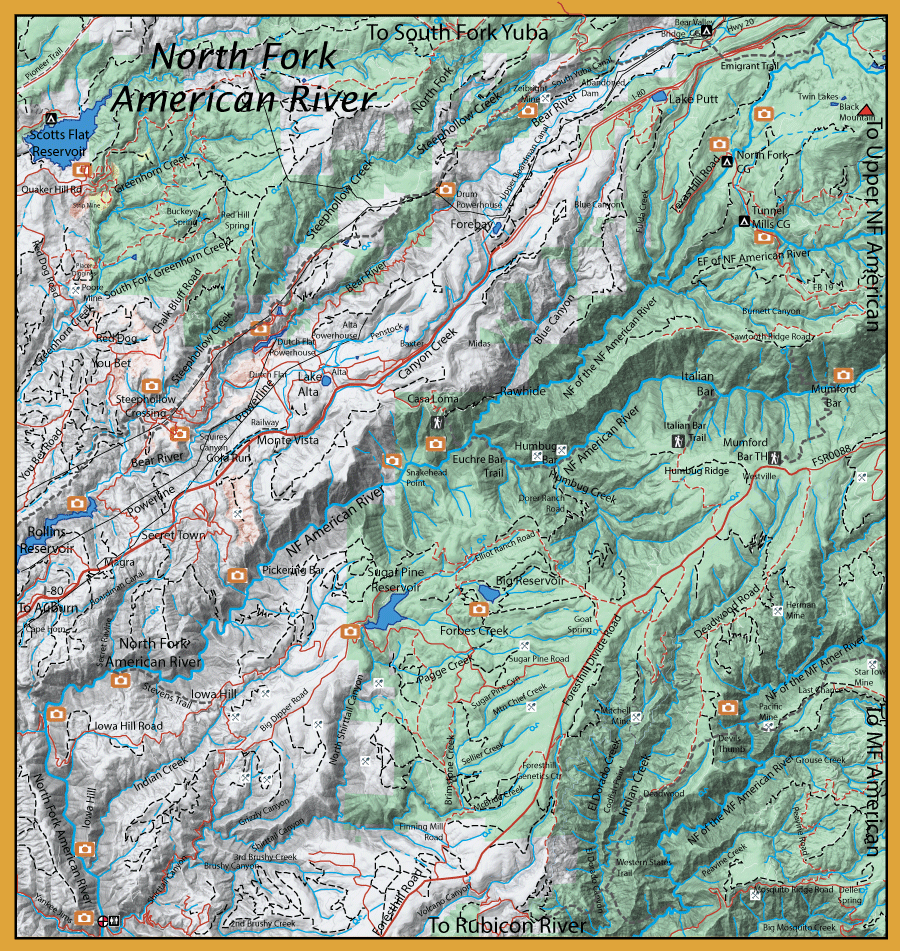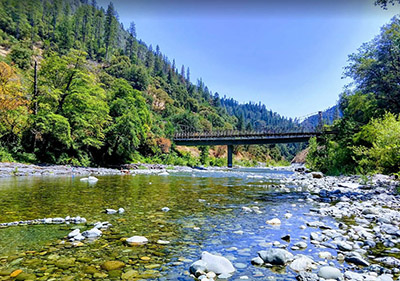North Fork American River – steep canyons with rainbows

 | |||
| Suggested Flies for the North Fork American River area: Sierra Tahoe Hatch Selection | |||
Stillwater Flies: | Nymphs: | Drys: | |
Directions: From Auburn, on Highway I-80, go Northeast 2 miles to Auburn-Foresthill Road. Turn East and go 18 miles to Foresthill. Continue on Foresthill-Soda Springs Road. Five trails provide access to the North Fork: 1) Green Valley Trail starts 3 miles from the dam at Sugar Pine Reservoir off Elliott Ranch Road. 2) Italian Bar Trail is 12 miles from Foresthill, turn left on Humbug Ridge Road and go 3 miles to Italian Bar trailhead. 3) Mumford Bar Trailhead is 13 miles from Foresthill on Foresthill Road 4) Beacroft Trailhead is 17 miles from Foresthill on Foresthill Road. and 5) Sailor Flat is another 5 miles further on Foresthill Road but the trailhead starts off a high clearance 4 WD road that goes 2 miles to the left. Most of these trails are 3-4 miles to the river and drop about 2000 feet. The American River Trail is along the North Fork and follows the south side of the river from Mumford Bar to Sailor Flat. | ||
Notes: The North Fork of the American is a State and National Wild and Scenic River. The river flows from Mountain Meadow Lake at 7,900 ft. and joins the Middle Fork American River near Auburn. Within the headwaters, three small streams join near The Cedars to form a significant flow. The river drops about 1500 feet as it enters Royal Gorge. Below the gorge is your best opportunity for access and fishing. There are three trails providing river access at Euchre Bar, Italian Bar, and Mumford Bar. The 37 miles stretch above the bridge at Iowa Hill Road near Colfax is in the California Wild Trout program, so that no fish are planted in this section. The bridge is also the only drive-in access to the North Fork Wild Trout section. The Wild Trout section ends at the confluence of Palisade Creek. Below Iowa Hill Bridge, the river tends to get too warm for trout and becomes a smallmouth bass fishery. The river consists of deep pools, as well as cascading waterfalls, with riffles, runs, and pocket water. Steep canyon slopes frame a narrow bottom. Most of the fish are Rainbows in the 8-15 inch size. Occasionally, you’ll find some larger Browns. Flows drop substantially by August and September. Fishing is open year-round with the General Fishing Season ending Nov 15th. From Nov 16th to the last Saturday of April, it is C&R only with single barbless hooks. The Euchre Bar area of the North Fork contains many rainbows 10 to 14 inches as well as a few Browns. The North Fork American has typical hatches of Caddis, Mayflies, and Golden Stones. Crystal Buggers work well, try yellow, black, and olive colors. Also use attractor beadhead nymphs as well as dries such as Adams and Humpies. North Fork of the North Fork American River: This is a tailwater tributary out of Lake Valley Reservoir. It consists of small pools with rocky runs and pocket water. Near the reservoir, the tributary is mostly Browns in the 9-12 inch class. The North Fork campground is about 3 miles downstream where Forest Road 19 crosses and is reached from the Emigrant Gap exit off I-80. This stretch gets planted with Rainbows, many Browns remain mixed with the Rainbows. The wild trout will occur a short distance either upstream or downstream from the campground. Rainbows will be 6-10 inches. East Fork of the North Fork of the North Fork American River: This is a small stream with Rainbows in the 6-9 inch class. It contains small pools with runs and pocket water. It can be reached from Forest Road 19 about 7 miles past the North Fork campground. North Fork of the Middle Fork American River: This water consists of small pools, runs, and pocket water. The Rainbows tend to be on the small size of 6-8 inches. The river is within a very deep canyon which tends to cool the ambient temperature. There are good hatches of Mayflies and Golden Stones. Scotts Flat Reservoir: (661 acres at 3,069 feet elev) This lake has both warmwater and coldwater fish with a maximum depth of 80 feet. The lake contains Brown Trout, Rainbow Trout, Kokanee, Large Mouth Bass, Small Mouth Bass, Spotted Bass, Bullhead Catfish and Channel Catfish. The lake is known for a good smallmouth bite particularly in the winter and early spring. Also a good fishery for the browns in the fall as they stage within the creek inlets. Steephollow Creek: This is the largest tributary within the Upper Bear River watershed. Has had a history of goldmining, particularly hydraulic mining with the use of mercury, and is listed within the Clean Water Act as having an impaired waterbody with mercury contamination. Contains Browns and Rainbows. Bear River: Bear River is about 74 miles long and flows from 5,000 feet just below Lake Spaulding to 35 feet where it meets the Feather River. This river has been greatly impacted by both mining and water projects. This watershed was impacted by hydraulic mining from 1850 to 1884. Sediment was carried downstream and threatened the farmlands of the Central Valley. Creeks and rivers were diverted to bring water to the 30 mine sites on the Bear River. Hydraulic mining was discontinued in 1884 due to lawsuits from the farmers. However, over 2.5 million pounds of mercury was used by these miners and much of this mercury has also settled into the sediment collecting within downstream reservoirs. Microorganisms break down the mercury into methyl mercury which can be consumed by fish and other animals. The highest concentrations have been found below Rollins Lake. This mercury problem will most likely take a few hundred years until the watershed can get back to it’s pre-mining state. Rollins Reservoir: (840 acres at 2,170 feet elev) A popular lake with over 300,000 visitors over the Summer months. The reservoir contains Rainbows, Catfish, Bluegill, Largemouth Bass, Smallmouth Bass, Brown Trout, and Carp. The lake is deep, up to 280 feet, providing cooler water temps for the trout to retreat to when the surface water temp reaches 75 degrees in the summer. Best fishing occurs in the Fall, Winter, and Spring. CDFW stocks the lake with about 6,000 rainbows annually 10-12 inches. Smallmouth Bass are probably the most prolific species caught within the reservoir until recently when introduced Spotted Bass have become plentiful and is taking over the bass populations.. Drum Forebay: (20 acres at 4,744 feet elev) Contains Rainbows, Browns, Smallmouth Bass, and Channel Catfish. Cold water is pumped into the forebay from Spaulding Lake. The pond is not stocked but fish seem to get there anyway through the conduit. Lake Putt: Stocked with fish during the early 1900’s and the pond continues to have a healthy number of warmwater species. Contains, Smallmouth Bass, Bluegill, and Channel Catfish. Sugar Pine Reservoir: (160 acres at 3,500 feet elev). Created in 1982 and serving the community of Foresthill. It was stocked with Browns up until 1990. Browns still reside here but in few numbers. This is a stocked lake in which CDFW puts in 8,000 to 16,000 pan size Rainbow trout from May through July. Some of these trout become holdovers and reach 14-20 inches the following year. Best fished in the Spring. Contains Rainbows, Browns, and Smallmouth Bass. Big Reservoir, aka Morning Star Lake: (80 acres at 3,620 feet elev): This is a private lake stocked with Rainbows, Largemouth Bass, and Channel Catfish. Cost is about $30/day for fishing and camping is also available.
| ||
Fishing RegulationsAmerican River, North Fork, Middle Fork, South Fork and their tributaries above Folsom Lake (Placer, El Dorado, Amador and Alpine cos.): Saturday preceding Memorial Day through September 30th. 5 trout, no gear restrictions. Summer fishing only to protect Spring and Fall Spawning. Bear River from Highway 20 south downstream 2.5 miles to the abandoned concrete dam (the Boardman Diversion Dam).: Saturday preceding Memorial Day through the last day in February. 5 trout, no gear restrictions. Spring angling closure to protect Spawning. Bear River downstream of the abandoned concrete dam (the Boardman Diversion Dam).: Last Saturday in Apr. through Nov. 15. No restrictions. 5 trout per day. 10 trout in possession. All Lakes and Reservoirs: Open all year. No restrictions. 5 trout per day. 10 trout in possession. All other creeks and tributaries: Last Saturday in Apr. through Nov. 15. No restrictions. 5 trout per day. 10 trout in possession.
| ||
